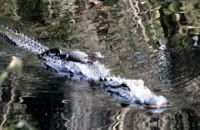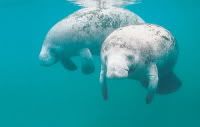
Florida Fish and Wildlife Commission preparing for effects of climate change
By Susan Cocking
Miami Herald
October 5, 2008
Scientists addressing the Florida Fish and Wildlife Conservation Commission's first climate change summit last week forecast a bleak future for the state's fish and wildlife over the next century:
• As many as 30 percent of native species could face extinction from habitat loss because of rising ocean levels.
• Coral reefs could begin dissolving in 10 to 12 years as increasing carbon dioxide levels make oceans more acidic.
• South Florida's mangrove forests could be greatly reduced or even lost, leading to increasing storm surges.
• Invasive species such as melaleuca trees and blue tilapia -- a hardy freshwater fish from South America -- will spread north, crowding out Florida's remaining native plants and animals.
''We don't have to wait for the future; it's already here,'' Hal Wanless, chairman of the geological sciences department at University of Miami, told workshop participants Wednesday.
The three-day session might have been the first of its kind organized by a state agency. Chuck Collins, FWC southeast regional director, said Florida really is on the front line of global climate change because it sticks out like a thumb from the rest of the North American continent with 8,000 miles of shoreline, making it very susceptible to sea level rise and forecast increases in major storms.
Ironically, the summit -- originally scheduled in August -- had to be postponed because of Tropical Storm Fay. It is expected to lead to the development of policies and strategies aimed at minimizing impacts on fish, plants and animals.
''We are experts on wildlife management but not climate change,'' Collins said.
Speakers at the summit's opening session Wednesday said Florida policymakers must act now to prepare for what Wanless called ``changes to Florida and Earth beyond your wildest imagination.''
As polar ice sheets melt, he said, South Florida could experience a 1 ½-foot rise in sea level over the next 50 years, and a three- to five-foot rise by the end of the century.
''Turkey Point is out in the middle of Biscayne Bay with a three-foot rise,'' Wanless said. ``With a four- to five-foot rise in sea level, all our barrier islands will be abandoned. The Everglades would be overwhelmed. The difference between a one- to two-foot rise and a three- to five-foot rise is all the difference between messy and wet, and totally unliveable and loss of coastal environments.''
Thomas Eason, in charge of habitat and species conservation for the FWC, cited several examples of how climate change already is affecting Florida's wildlife.
''There's been a 50 percent reduction in coral cover in the Keys since 1996,'' Eason said. ``The common snook is now seen off Alabama. Blue tilapia have expanded their range 50 miles northwest all the way up to Gainesville. Sooty terns are nesting 1-2 months earlier. The brown pelican and wood stork center of breeding has moved northward.''
Reed Noss, a professor of conservation biology at University of Central Florida, predicted that as sea levels rise, about half of Florida's population would be forced to move away from the coasts, crowding into inland regions such as the Lake Wales Ridge and Kissimmee Valley. The human influx, Noss said, would crowd out wildlife, such as the endangered Florida panther. He recommended the creation of large upland preserves with travel corridors for fleeing wildlife.
''Is it cost-effective to spend billions on Everglades restoration, or would funds be better spent to move species upland?'' Noss said.
To stem the loss of coral reefs, Robert van Woesik, a biology professor at Florida Institute of Technology, recommended designating networks of marine protected areas with no fishing allowed.
''Local protection leads to local benefits,'' he said. ``Protection really does matter.''
Other speakers advocated stepping up efforts to control non-native species; allowing natural coastal ecosystems -- not seawalls -- to buffer shorelines; reducing manmade stressors, such as carbon emissions; and restoring natural freshwater flows to lakes and rivers.
Said Len Berry, director of the Center for Environmental Studies at Florida International University: ``The message to take from this is that planning needs to start now. We want to come out of here with things we ought to be concentrating on.''

Wildwood Preservation Society is a non-profit 501(c)(4) project of the Advocacy Consortium for the Common Good. Click here to learn more.
"it's all connected"













No comments:
Post a Comment